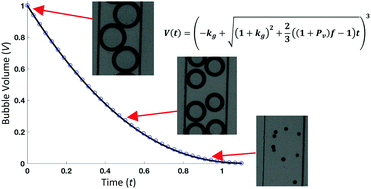当前位置:
X-MOL 学术
›
Soft Matter
›
论文详情
Our official English website, www.x-mol.net, welcomes your feedback! (Note: you will need to create a separate account there.)
Shrinking microbubbles with microfluidics: mathematical modelling to control microbubble sizes
Soft Matter ( IF 3.4 ) Pub Date : 2017-11-07 00:00:00 , DOI: 10.1039/c7sm01418j A. Salari 1, 2, 3, 4, 5 , V. Gnyawali 3, 4, 5, 6, 7 , I. M. Griffiths 8, 9, 10, 11 , R. Karshafian 3, 4, 5, 6, 7 , M. C. Kolios 3, 4, 5, 6, 7 , S. S. H. Tsai 3, 4, 5, 6, 7
Soft Matter ( IF 3.4 ) Pub Date : 2017-11-07 00:00:00 , DOI: 10.1039/c7sm01418j A. Salari 1, 2, 3, 4, 5 , V. Gnyawali 3, 4, 5, 6, 7 , I. M. Griffiths 8, 9, 10, 11 , R. Karshafian 3, 4, 5, 6, 7 , M. C. Kolios 3, 4, 5, 6, 7 , S. S. H. Tsai 3, 4, 5, 6, 7
Affiliation

|
Microbubbles have applications in industry and life-sciences. In medicine, small encapsulated bubbles (<10 μm) are desirable because of their utility in drug/oxygen delivery, sonoporation, and ultrasound diagnostics. While there are various techniques for generating microbubbles, microfluidic methods are distinguished due to their precise control and ease-of-fabrication. Nevertheless, sub-10 μm diameter bubble generation using microfluidics remains challenging, and typically requires expensive equipment and cumbersome setups. Recently, our group reported a microfluidic platform that shrinks microbubbles to sub-10 μm diameters. The microfluidic platform utilizes a simple microbubble-generating flow-focusing geometry, integrated with a vacuum shrinkage system, to achieve microbubble sizes that are desirable in medicine, and pave the way to eventual clinical uptake of microfluidically generated microbubbles. A theoretical framework is now needed to relate the size of the microbubbles produced and the system's input parameters. In this manuscript, we characterize microbubbles made with various lipid concentrations flowing in solutions that have different interfacial tensions, and monitor the changes in bubble size along the microfluidic channel under various vacuum pressures. We use the physics governing the shrinkage mechanism to develop a mathematical model that predicts the resulting bubble sizes and elucidates the dominant parameters controlling bubble sizes. The model shows a good agreement with the experimental data, predicting the resulting microbubble sizes under different experimental input conditions. We anticipate that the model will find utility in enabling users of the microfluidic platform to engineer bubbles of specific sizes.
中文翻译:

用微流控技术收缩微气泡:控制微气泡尺寸的数学模型
微气泡在工业和生命科学中都有应用。在医学中,小囊泡(<10μm)是理想的,因为它们可用于药物/氧气输送,声穿孔和超声诊断。尽管存在多种产生微气泡的技术,但是微流体方法因其精确的控制和易于制造而得以区别。然而,使用微流体产生直径小于10μm的气泡仍然具有挑战性,并且通常需要昂贵的设备和繁琐的设置。最近,我们的小组报告了一种微流体平台,该平台可将微气泡缩小至10微米以下的直径。微流体平台利用简单的微气泡产生流聚焦几何形状,并与真空收缩系统集成在一起,以实现医学上所需的微气泡尺寸,并为最终临床吸收微流产生的微气泡铺平了道路。现在需要一个理论框架来关联产生的微气泡的大小和系统的输入参数。在本手稿中,我们表征了由具有不同界面张力的溶液中流动的各种脂质浓度制成的微泡,并监测了在各种真空压力下沿微流道的泡大小的变化。我们使用控制收缩机制的物理学原理来开发数学模型,该数学模型可以预测生成的气泡大小并阐明控制气泡大小的主要参数。该模型显示出与实验数据的良好一致性,可以预测在不同实验输入条件下产生的微气泡大小。
更新日期:2017-11-14
中文翻译:

用微流控技术收缩微气泡:控制微气泡尺寸的数学模型
微气泡在工业和生命科学中都有应用。在医学中,小囊泡(<10μm)是理想的,因为它们可用于药物/氧气输送,声穿孔和超声诊断。尽管存在多种产生微气泡的技术,但是微流体方法因其精确的控制和易于制造而得以区别。然而,使用微流体产生直径小于10μm的气泡仍然具有挑战性,并且通常需要昂贵的设备和繁琐的设置。最近,我们的小组报告了一种微流体平台,该平台可将微气泡缩小至10微米以下的直径。微流体平台利用简单的微气泡产生流聚焦几何形状,并与真空收缩系统集成在一起,以实现医学上所需的微气泡尺寸,并为最终临床吸收微流产生的微气泡铺平了道路。现在需要一个理论框架来关联产生的微气泡的大小和系统的输入参数。在本手稿中,我们表征了由具有不同界面张力的溶液中流动的各种脂质浓度制成的微泡,并监测了在各种真空压力下沿微流道的泡大小的变化。我们使用控制收缩机制的物理学原理来开发数学模型,该数学模型可以预测生成的气泡大小并阐明控制气泡大小的主要参数。该模型显示出与实验数据的良好一致性,可以预测在不同实验输入条件下产生的微气泡大小。



























 京公网安备 11010802027423号
京公网安备 11010802027423号